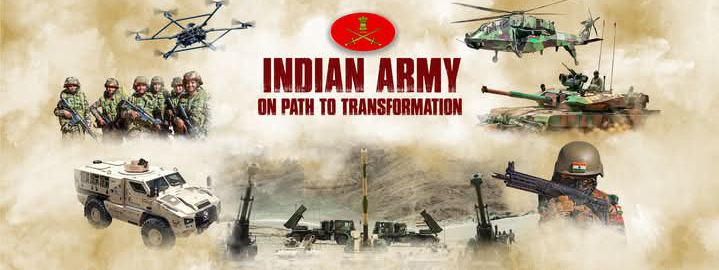Military Engineering Empowering the Defense System of the Indian Army : A Pillar of Strength and Security
In the vast and diverse landscape of India, the nation's security and sovereignty are safeguarded by a formidable and technologically advanced defense system. Central to this robust security architecture is the domain of military engineering, which plays a pivotal role in empowering the Indian Army, Navy, and Air Force. Military engineering encompasses a broad spectrum of disciplines, including construction, infrastructure development, battlefield engineering, explosive safety, and technological innovation. These engineering marvels not only enhance operational efficiency but also ensure the safety, well-being, and strategic advantage of Indian defense forces during complex warfare situations.
The recent Operation Sindoor exemplifies the strategic reinforcement and empowerment of India’s defense capabilities through the collaboration of multiple military branches and defense research organizations. The Indian Army, Navy, and Air Force worked in tandem with the Defence Research and Development Organisation (DRDO) to strengthen infrastructure, develop innovative technologies, and execute precise operational tactics. This joint effort underscores the importance of military engineering in modern warfare, where technology, infrastructure, and strategic planning converge to protect the nation’s interests.
Military engineering's contribution to Operation Sindoor highlights the significance of specialized technical support in contemporary warfare. From constructing fortified bunkers and secure communication lines to deploying advanced weapon systems and surveillance technology, military engineers ensure that armed forces are equipped to respond effectively to emerging threats. Their expertise in explosive engineering, including the safe handling and disposal of hazardous materials, minimizes collateral damage and enhances operational safety. This technical prowess is vital in maintaining the readiness and resilience of India’s defense forces in a rapidly evolving security landscape.
Furthermore, military engineering extends beyond combat zones to encompass disaster management and humanitarian assistance, reinforcing the army’s role as a protector of civilians. During Operation Sindoor, engineers played a crucial role in establishing emergency infrastructure, providing medical facilities, and ensuring communication networks remained intact, even in adverse conditions. These efforts demonstrate the integral role of military engineering in saving lives, safeguarding communities, and maintaining national stability during crises.
The technological innovations driven by DRDO in collaboration with military engineers have revolutionized India’s defense capabilities. Cutting-edge materials, robotics, unmanned systems, and cyber defense tools are now integral to India’s strategic arsenal. For instance, the development of indigenously designed armored vehicles, advanced missile systems, and stealth technology has significantly elevated India’s defense posture. These innovations, rooted in military engineering science and technology, foster self-reliance and reduce dependency on foreign technology, aligning with India’s vision of a strong and autonomous defense system.
In addition to technological advancements, military engineering fosters skill development and capacity building within the armed forces. Specialized training programs in combat engineering, explosive handling, and infrastructure management equip personnel with the expertise needed to undertake complex missions efficiently. This continuous capacity enhancement ensures that India’s defense forces remain agile, innovative, and prepared to counter evolving threats, whether conventional or asymmetric.
The strategic importance of military engineering is further exemplified by India’s focus on infrastructure modernization along its borders. Constructing durable roads, bridges, tunnels, and fortified positions enhances mobility and logistical support for troops in remote areas. These engineering feats enable rapid deployment and sustainment of forces, ensuring a swift and decisive response to any external aggression. In a geopolitical context, such infrastructure development acts as a deterrent and affirms India’s commitment to national security.
The integration of military engineering with cutting-edge research and development efforts illustrates India’s holistic approach to defense modernization. The synergy between engineering science, technological innovation, and strategic planning creates a resilient defense ecosystem capable of addressing both current and future security challenges. This integrated approach not only safeguards India’s sovereignty but also positions the nation as a major player in global defense technology.
In conclusion, military engineering stands as a cornerstone of India’s defense system, empowering armed forces with technological innovations, strategic infrastructure, and operational expertise. The success of missions like Operation Sindoor underscores the critical role played by military engineers in safeguarding national interests and saving lives during warfare and crises. As India continues to advance its defense capabilities through research, innovation, and dedicated engineering efforts, it reaffirms its commitment to maintaining peace, security, and sovereignty in an increasingly complex world
---
1. Military engineering in India integrates cutting-edge technology and strategic infrastructure to strengthen the nation’s defense capabilities.
2. The collaborative efforts during Operation Sindoor showcase how military engineers and research organizations work together to enhance operational readiness.
3. Innovations in explosive safety, robotics, and cyber defense are transforming India’s military landscape, making it more resilient and autonomous.
4. Specialized training and capacity building in military engineering ensure that Indian armed forces remain agile and prepared for diverse threats.
5. Infrastructure development along borders, including roads and tunnels, is vital for rapid deployment and operational efficiency of Indian forces.
6. Military engineering’s role in disaster management and humanitarian aid highlights its importance beyond conventional warfare, protecting civilians and saving lives.
---









No comments:
Post a Comment